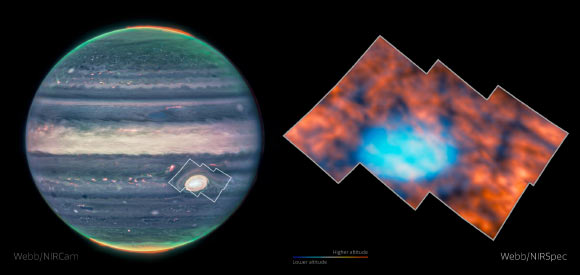Jupiter’s upper atmosphere is composed of a neutral thermosphere and charged ionosphere. Astronomers using the NASA/ESA/CSA James Webb Space Telescope have spotted unexpected small-scale intensity features such as arcs, bands and spots in Jupiter’s low-latitude ionosphere in the region above the Great Red Spot.
This graphic shows the region observed by Webb: first its location on a NIRCam image of the whole planet (left), and the region itself (right), imaged by Webb’s Near-InfraRed Spectrograph (NIRSpec). Image credit: NASA / ESA / CSA / Webb / Jupiter ERS Team / J. Schmidt / H. Melin / M. Zamani, ESA & Webb.
Jupiter is one of the brightest objects in the night sky, and it is easily seen on a clear night.
Aside from the bright northern and southern lights at the planet’s polar regions, the glow from Jupiter’s upper atmosphere is weak and is therefore challenging for ground-based telescopes to discern details in this region.
However, Webb’s infrared sensitivity allows scientists to study Jupiter’s upper atmosphere above the infamous Great Red Spot with unprecedented detail.
The gas giant’s upper atmosphere is the interface between the planet’s magnetic field and the underlying atmosphere.
Here, the bright and vibrant displays of northern and southern lights can be seen, which are fuelled by the volcanic material ejected from Jupiter’s moon Io.
However, closer to the equator, the structure of the planet’s upper atmosphere is influenced by incoming sunlight.
Because Jupiter receives only 4% of the sunlight that is received on Earth, astronomers predicted this region to be homogeneous in nature.
University of Leicester astronomer Henrik Melin and his colleagues observed the Great Red Spot in July 2022 using the Integral Field Unit of Webb’s Near-InfraRed Spectrograph (NIRSpec).
Their Early Release Science observations sought to investigate if this region was in fact dull, and the region above the iconic Great Red Spot was targeted for Webb’s observations.
They were surprised to discover that the upper atmosphere hosts a variety of intricate structures, including dark arcs and bright spots, across the entire field of view.
“We thought this region, perhaps naively, would be really boring. It is in fact just as interesting as the northern lights, if not more so. Jupiter never ceases to surprise,” Dr. Melin said.
Although the light emitted from this region is driven by sunlight, the team suggests there must be another mechanism altering the shape and structure of the upper atmosphere.
“One way in which you can change this structure is by gravity waves — similar to waves crashing on a beach, creating ripples in the sand,” Dr. Melin said.
“These waves are generated deep in the turbulent lower atmosphere, all around the Great Red Spot, and they can travel up in altitude, changing the structure and emissions of the upper atmosphere.”
“These atmospheric waves can be observed on Earth on occasion, however they are much weaker than those observed on Jupiter by Webb.”
“We hope to conduct follow-up Webb observations of these intricate wave patterns in the future to investigate how the patterns move within the planet’s upper atmosphere and to develop our understanding of the energy budget of this region and how the features change over time.”
The findings appear in the journal Nature Astronomy.
_____
H. Melin et al. Ionospheric irregularities at Jupiter observed by JWST. Nat Astron, published online June 21, 2024; doi: 10.1038/s41550-024-02305-9








































































